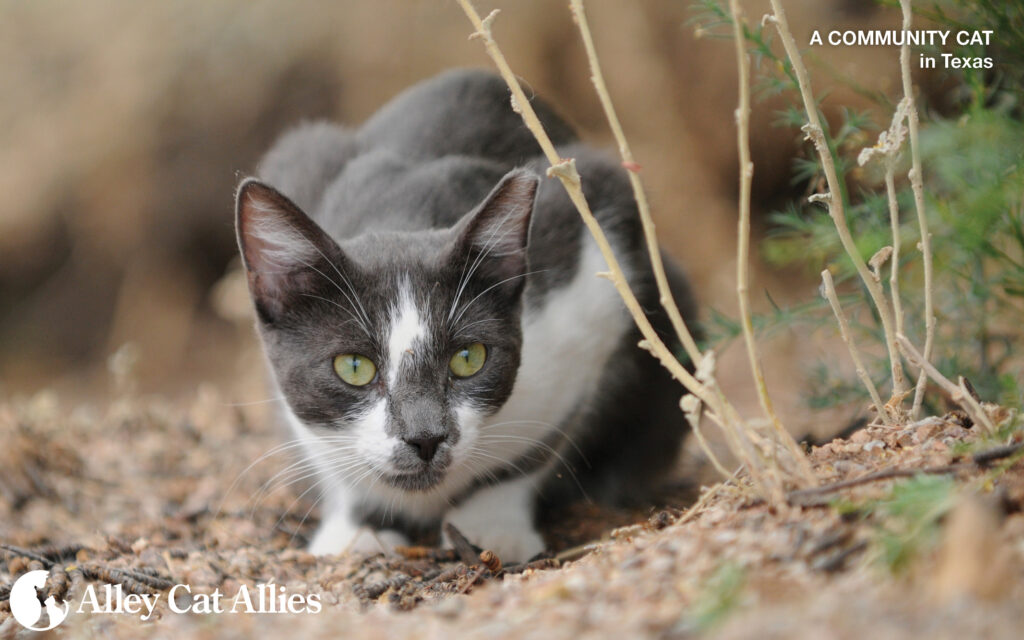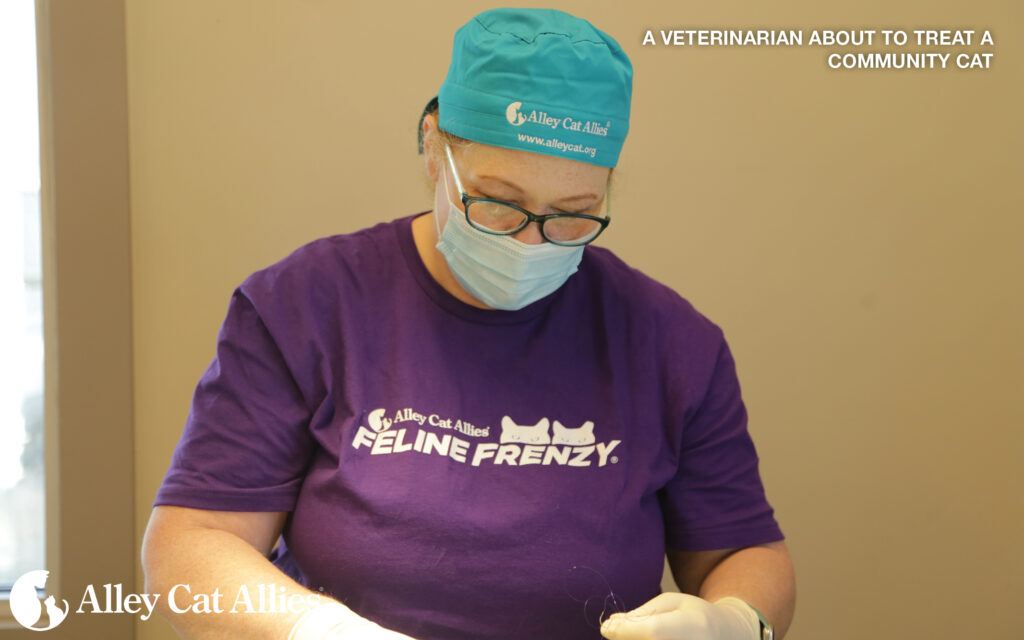TNR Scenarios: How to Help Sick or Injured Cats
This information is not intended to act as veterinary or other licensed medical advice for animals/cats, or to be a substitute for the advice of a licensed veterinarian or other animal medical professional. A licensed veterinarian should always be consulted for any health issues related to a cat.
PLEASE READ:
If you trap a community cat because she is sick or injured, she must see a veterinarian IMMEDIATELY. Do not trap a cat without a plan in place for her care. It is NOT acceptable or effective to bring a community cat indoors, confine her to a cage for days, weeks, or months, and not seek veterinary care. Doing so is not helping, it is CRUEL.
Do not wait; contact a veterinarian before even setting out to trap the cat. Rush her to an emergency veterinarian if she is trapped at a time when your usual community cat-friendly veterinarian is not open.
If you feel you are unable to provide this immediate care, contact a local advocate, organization, or veterinarian who can take the necessary steps to help. You can find resources for cats in your area with the Alley Cat Allies Community Resource Tool™.
Access our Community Resource Tool
Your local veterinarian may also be willing to help and discuss affordable options, so it is always worth it to call.
Please know: Community cats, and all cats, are very stressed by long-term confinement, and it can be detrimental to their health and well-being, especially when they are already ill or injured.
STEP ONE: Determine the nature of illness or injury
If a cat is in severe condition, emergency veterinary care is critical and time is of the essence. Look for:
- Respiratory distress (struggling to breathe, breathing too fast, chest moving fast)
- Open wounds or other visible injuries
- Limping, dragging part of body
- Clouded or crusted eyes, holding eye closed
- Blood on any part of the cat
- Lethargy or immobility
- Swollen limbs
- Bump or mass on body
- Repeatedly attempting and failing to go to the bathroom
- Severe hair loss
- Severe hair matting
- Severe weight loss and emaciation
- Yowling or crying that indicates pain
STEP TWO: Consult a veterinarian with community cat experience
A veterinary professional can evaluate whether a cat needs to be brought to the clinic right away for an illness or injury. Before taking any action, contact your chosen veterinarian and describe the cat’s condition. If you can, share photos or videos of the cat.
For community cats with mild issues, it may be best to allow them to heal in their outdoor home rather than trapping them.
Ask about the animal hospital, clinic, or veterinarian’s euthanasia policy and/or community cat or feral cat policy.
Alley Cat Allies advocates euthanasia only if a cat is in terminal condition. Unfortunately, some veterinarians who haven’t been trained to work with community cats may suggest “euthanizing” (i.e. killing) community cats rather than treating them.
Testing positive for FIV and FeLV is NOT a reason to euthanize a cat.
You can only make the best decisions for cats by asking questions and being aware of your veterinarian’s community cat policies.
Go to an emergency veterinarian rather than wait
If a cat has an emergency condition, an emergency veterinarian may be necessary. Your usual veterinarian may not have space, though you can call them first to determine. Make sure the veterinarian is ready to:
- Handle a community cat, including in a humane trap
- Scan the cat for a microchip to determine if she has a family or is a colony cat
- Depending on the cats’ condition…
- Provide fluids
- Take bloodwork for testing
- Provide X-rays, or other types of scan
- Provide medications and other treatments that last long-term, including flea treatment/preventative and Convenia®
STEP THREE: Humanely trap the cat
Be creative with trapping
Sick or injured cats may be more wary of entering humane traps. We have tips that can help you trap skeptical, cautious community cats.
See our tips for hard-to-trap cats
Add comfort padding in a cat’s trap or carrier if needed
Consider the condition of the cat and if she will need extra padding to be more comfortable. A cat with an injury may experience discomfort without a thick towel or blanket covering the bottom of the trap or carrier.
Apply the padding of your choice BEFORE the cat is trapped.
Do NOT open the humane trap or carrier
Your veterinarian should be the next person to open the trap door.
Transport the cat to the veterinarian immediately
Place the cat in a car (NOT in a trunk or open truck bed) and take the fastest route to the veterinarian. Avoid bumpy roads and navigate turns as gently as possible to avoid jostling the cat.
Be sure the veterinarian scans the cat for a microchip as soon as possible!
STEP FOUR: Develop a long-term recovery plan
In the best-case scenario, the cat will be returned to her outdoor home as quickly as possible. Determine if the cat can be treated outdoors rather than confined to an indoor space. Any treatment for a community cat should be as easy and non-invasive as possible to minimize further stress.
- Ask for liquid suspension, powder, or granule formulas of medications. These can be mixed into wet food.
- Giving topical medications (applied directly to the body) may be possible depending on the cat. Use your knowledge of the cats as individuals and consult with your veterinarian.
- Do not feed the cat who needs treatment right near other cats. Feed her from a separate plate or bowl to ensure she is eating and another cat is not taking her food.
- If putting medication in food, the medicated cat should be monitored at all times to ensure she is the only one who eats that food (and that she eats it all). Do not walk away. Medication can be harmful to cats for whom it was not intended.
- Monitor the cat regularly to ensure she is healing. Make an effort to have eyes on her multiple times a day.
- Throughout the cats’ treatment and recovery process, provide wet food, which is far better than dry for hydration. Try to provide the highest-quality wet food that is possible to afford; the cat will need all the nutrients she can to heal.
Based on the severity of illness or injury, a cat might need to be placed in a long-term holding area for recovery. Whether that recovery is done in your home or the veterinary clinic, plan beforehand so you don’t have to scramble at the last minute.
Connect with your veterinarian and determine if they will house the cat during recovery, or for advice on how to create the best possible recovery space in your home. Remember that any indoor recovery must be for as short a length of time as possible to minimize stress.
Longer-term confinement should NOT be…
- A humane box trap
- A carrier
- A small cage
- A room with places the cat can climb into, squeeze under, or otherwise be unreachable
For longer-term recovery areas…
Utilize as large a holding area as possible
A feral cat recovery cage, large crate, cat condo, or cat playpen is ideal. Make sure the recovery space is in a temperature-controlled area kept at around 70 degrees.
Line the bottom of the holding area with newspaper
This way, regular cleaning is easier.
Set up a smaller cat den inside the space
Place a feral cat den (best option) or carrier (acceptable but less ideal) inside the larger space, flush against one of its back corners. This is a critical step to give the cat a safe place to hide and relax, and to make it easier to clean the space or remove the cat when ready.
The cat should be INSIDE the closed den or carrier and then placed into the larger space to avoid injury or other difficulties in transferring. If the cat was formerly in a humane trap to travel to the veterinarian, the veterinarian can place the cat in the den or carrier before you take them home.
A yardstick, broom handle, or other large, firm object can be inserted in to help open the den or carrier’s door to let the cat out (slide the stick just in front of a carrier’s door to keep it from opening all the way as you latch or unlatch it
Provide food, water, and litter
Place the food and water in an area you can easily access, but that is away from the litter box. You will need to provide nutritious food and water regularly, as well as clean any soiled newspaper or litter.
To ensure your and the cats’ safety, coax the cat into their den or carrier and close it before opening the larger enclosure. Community cats will usually dart into their “safe space” immediately upon seeing you.
Cover the entire setup
Use a sheet or other breathable cover that can cover the whole large enclosure to help the cat feel safe. She must be as stress-free as possible to successfully and swiftly recover.
Monitor the cat regularly
You should have eyes on the recovering cat multiple times a day, and keep regular contact with the veterinarian to ensure milestones are being met and to relay any concerns about the cat’s condition.
As soon as the cat has recovered enough, return her to her outdoor home and continue any further medications or antibiotics there.
More Important Information
Because they will not thrive outdoors, DO NOT return community cats who…
- Are declawed
- Are missing a limb
- Have all their teeth removed as treatment for stomatitis
DO NOT keep community cats in any confined space indefinitely. There is never a reason for a cat to be in a cage for months. The goal should be to return her to her outdoor home or, if that is not possible, acclimate her to an indoor space.
Help funding needed care
As a community cat advocate, it’s always wise to plan ahead for how you’ll pay for veterinary bills, including any beyond the usual spay or neuter, vaccination, and eartip. Use our tips on developing resources for cat care to help create an emergency medical fund, or for ideas on how to negotiate a payment plan with your veterinarian.
You can also find financial resources at alleycat.org/Economy.



